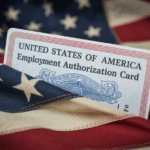Many H-1B visa holders aim to turn their temporary status into permanent residency in the U.S. The most common path? Employment-based green cards — specifically through the EB-2 and EB-3 categories.
Thousands of skilled professionals come to the U.S. every year on H-1B visas, but long-term goals often include staying permanently. That’s where the employment-based green card process comes in — allowing H-1B workers to apply for permanent residence with employer sponsorship.
However, the process isn’t as simple as filling out a form. It involves multiple steps, government approvals, and choosing the right green card category. In this guide, we’ll explain exactly how to move from an H-1B visa to a green card, including the EB-2 and EB-3 paths that most applicants follow.
🇺🇸 What is a Green Card?
A Green Card (officially called a Permanent Resident Card) gives you the legal right to live and work permanently in the United States. It’s the final step before U.S. citizenship and offers major benefits compared to a temporary visa like H-1B.
Here’s what makes a Green Card better than staying on H-1B:
- No time limit or renewal required every 3 years
- Freedom to change jobs and employers without sponsorship
- Ability to sponsor your spouse and children for green cards
- Pathway to U.S. citizenship after 5 years
There are multiple ways to apply for a green card — including family sponsorship, asylum, and the diversity lottery — but employment-based sponsorship is the most common for H-1B holders.
For most H-1B workers, the green card process falls under the employment-based (EB) categories. These are divided into preference levels, from EB-1 (for individuals with extraordinary ability) to EB-5 (for investors). But for the majority of skilled professionals, the most relevant categories are:
- EB-2: For advanced degree holders or those with exceptional ability
- EB-3: For skilled workers, professionals with bachelor’s degrees, or other workers
Each category has its own eligibility rules, timelines, and advantages. Choosing the right one depends on your education, job role, and what your employer is willing to sponsor you for.
🧾 Employment-Based Green Cards: EB-2 vs EB-3
Let’s break down both categories:
EB-2 (Employment-Based Second Preference)
- Requires either:
- A job that needs an advanced degree (Master’s or higher)
- OR a Bachelor’s + 5 years of progressive experience
- OR proof of exceptional ability in your field
- A job that needs an advanced degree (Master’s or higher)
- Can also include EB-2 NIW (National Interest Waiver) for self-petitioners
- Typically faster than EB-3 (depending on country)
EB-3 (Employment-Based Third Preference)
- For:
- Professionals with at least a Bachelor’s degree
- Skilled workers with 2+ years of training/experience
- Unskilled workers (less common)
- Professionals with at least a Bachelor’s degree
- Requires full employer sponsorship
- Often a longer wait due to higher demand and more backlogs
🪜 Step-by-Step: How to Move from H-1B to Green Card
Transitioning from an H-1B visa to a green card isn’t automatic — it involves several legal steps, strict timelines, and coordination with your employer. The process typically takes anywhere from 1 to 3+ years, depending on your country of origin and the green card category (EB-2 or EB-3).
Here’s how the process works, step by step:
Step 1: PERM Labor Certification (ETA Form 9089)
- Your employer must test the U.S. labor market to prove there are no qualified American workers for your job.
- This includes job advertisements, recruitment, and paperwork submitted to the Department of Labor (DOL).
- Once approved, you get a PERM certification that’s valid for 180 days.
📌 Important: You cannot file the I-140 without an approved PERM.
Step 2: I-140 Immigrant Petition
- Your employer files Form I-140 with USCIS to prove they can financially support your employment.
- It also locks in your priority date, which determines your spot in line.
- If your priority date becomes current, you move to the next step.
⏱️ Processing Time: Usually 6–9 months (can be faster with premium processing).
Step 3: Priority Date & Visa Bulletin
- USCIS assigns a priority date based on your PERM approval.
- You must wait until your priority date is “current” (check the monthly Visa Bulletin published by the U.S. State Department).
- Wait times vary greatly based on country (India/China = longest waits) and EB category.
Step 4: I-485 Adjustment of Status (or Consular Processing)
- Once your date is current, you can file Form I-485 to adjust your status from H-1B to green card.
- If you’re outside the U.S., you’ll go through Consular Processing at a U.S. embassy.
- This includes biometrics, medical exam, and possibly an interview.
📎 Optional: If your priority date is already current at the time of I-140, you can do concurrent filing (I-140 + I-485 together) to save time.
Choosing the right green card category isn’t just about your job title — it’s about your qualifications, employer support, and country of origin. While both EB-2 and EB-3 lead to the same green card, timing and eligibility can vary widely.
Here’s a quick side-by-side comparison:
📊 EB-2 vs EB-3: Key Differences
| Feature | EB-2 | EB-3 |
| Education Requirement | Master’s degree or Bachelor’s + 5 yrs experience | At least a Bachelor’s degree or 2+ yrs skilled training |
| Eligible Job Roles | Data Scientists, Software Architects, Analysts | Developers, Teachers, Admins, Entry-Level Engineers |
| Application Speed | Generally faster (depending on priority dates) | Slower due to higher demand and backlogs |
| PERM Required? | ✅ Yes | ✅ Yes |
| I-140 Required? | ✅ Yes | ✅ Yes |
| Priority Date Wait Time | Often shorter (unless country is oversubscribed) | Usually longer (especially for India & China) |
| NIW Option Available? | ✅ Yes (self-petition possible under EB-2 NIW) | ❌ No |
| Job Offer Required? | ✅ Yes (unless NIW) | ✅ Yes |
| Who It’s Best For | Advanced degree holders or highly experienced workers | Bachelor’s grads or skilled workers with steady job offers |
Upgrading from EB-3 to EB-2
Sometimes, applicants who initially filed under EB-3 may later qualify for EB-2 — and want to “upgrade” their petition to benefit from faster processing times or shorter visa bulletin wait periods.
This is a common strategy, especially for Indian and Chinese applicants who face long EB-3 backlogs.
When Can You Upgrade from EB-3 to EB-2?
You may be eligible if:
- You’ve earned a Master’s degree or equivalent experience (Bachelor’s + 5 years)
- Your current job role has changed or now qualifies as EB-2 level
- Your employer is willing to sponsor you again at the EB-2 level
How Does the Upgrade Work?
- Your employer must restart the PERM process with a new job description at the EB-2 level
- File a new I-140 under EB-2 — but use your original EB-3 priority date
- Once your EB-2 I-140 is approved and the priority date is current, you can proceed with I-485
Risks & Considerations
- It’s not an automatic switch — it requires new paperwork, new costs, and employer cooperation
- If your priority date becomes current under EB-3 before EB-2 processing finishes, you may miss your window
- Not all job roles or employers qualify for EB-2 — it must be justified by job requirements, not just your degree
Tips to Speed Up the H-1B to Green Card Process
The green card process can feel long and uncertain, especially if you’re on a ticking H-1B timeline. But with proper planning and the right employer support, you can avoid delays and improve your chances of a smoother transition.
Here are some proven strategies to help speed things up:
1. Start the Process Early
- Don’t wait until your 5th or 6th year of H-1B.
- Starting PERM early (ideally by year 2 or 3) gives you more flexibility in case of delays or audits.
2. Use Premium Processing for I-140
- Paying extra for premium processing can get your I-140 approved in 15 calendar days instead of months.
- Faster approval = faster priority date lock-in.
3. Choose the Right EB Category
- If you’re eligible for EB-2, choose it — visa bulletins typically move faster than EB-3.
- EB-2 NIW (National Interest Waiver) is even better if you qualify and want to self-petition
4. Work with Immigration-Savvy Employers
- Some companies delay or avoid green card sponsorship.
- Choose employers who start the process proactively, understand legal steps, and hire experienced immigration lawyers.
5. Monitor Visa Bulletin Monthly
- Keep an eye on your priority date using the USCIS Visa Bulletin.
- Knowing when you can file I-485 helps with travel plans and status extensions.
⚠️ Common Mistakes to Avoid During the H-1B to Green Card Process
Even small errors in the green card journey can cause major delays — or worse, force you to leave the U.S. Avoiding these common pitfalls will help keep your case on track and reduce stress during an already complex process.
1. Waiting Too Long to Start PERM
- If you start late in your H-1B validity, you may run out of time before your green card is approved.
- Start early to avoid scrambling for extensions or leaving the U.S.
2. Switching Employers Mid-Process Without Planning
- Changing jobs while your PERM or I-140 is pending often resets the entire process.
- Make sure you understand AC21 portability rules before switching.
3. Not Maintaining H-1B Status
- Even during green card processing, you must maintain valid H-1B or other nonimmigrant status.
- Overstaying or unauthorized employment can jeopardize your green card.
4. Ignoring Visa Bulletin Changes
- Missing your “filing window” when your priority date becomes current can delay your I-485 filing.
- Track the Visa Bulletin every month to stay ahead.
5. Assuming All Employers Will Sponsor
- Not all companies offer green card sponsorship.
- Always confirm before accepting a job, especially during your H-1B years.
✅ Conclusion
Moving from an H-1B visa to a green card is a major step toward long-term stability and freedom in the United States. While the process can be complex and slow, understanding each step — from PERM to I-485 — can give you a clear path forward.
Whether you’re targeting the EB-2 or EB-3 category, working with a supportive employer and planning ahead can make all the difference. With the right guidance, your journey to U.S. permanent residency can be smooth, strategic, and successful.





